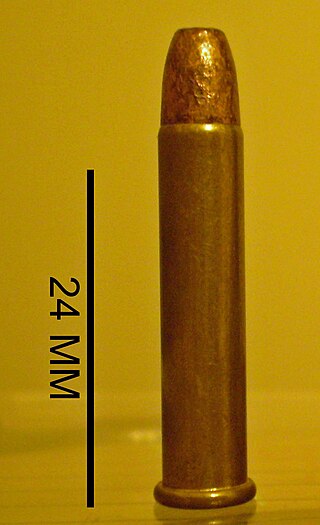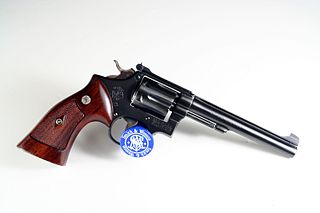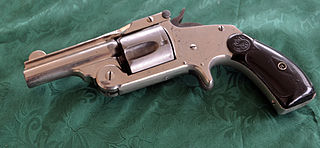
A revolver is a repeating handgun that has at least one barrel and uses a revolving cylinder containing multiple chambers for firing. Because most revolver models hold up to six cartridges, before needing to be reloaded, revolvers are commonly called six shooters or sixguns. Due to their rotating cylinder mechanism, they may also be called wheel guns.

Smith & Wesson Brands, Inc. (S&W) is an American firearm manufacturer headquartered in Maryville, Tennessee, United States.

The Colt Single Action Army is a single-action revolver handgun. It was designed for the U.S. government service revolver trials of 1872 by Colt's Patent Firearms Manufacturing Company and was adopted as the standard-issued pistol of the U.S. Army from 1873 to 1892.

The Smith & Wesson Model 29 is a six-shot, double-action revolver chambered for the .44 Magnum cartridge and manufactured by the United States company Smith & Wesson.

The .454 Casull is a firearm cartridge, developed as a wildcat cartridge in 1958 by Dick Casull, Duane Marsh and Jack Fullmer. It was announced in November 1959 by Guns & Ammo magazine. The design is a lengthened and structurally improved .45 Colt case. The wildcat cartridge went mainstream when Freedom Arms brought a single action five-shot revolver chambered in .454 Casull to the retail firearms market in 1983. Ruger followed in 1997, chambering its Super Redhawk in this caliber. Taurus followed with the Raging Bull model in 1998 and the Taurus Raging Judge Magnum in 2010. The .45 Schofield and .45 Colt cartridges can fit into the .454's chambers, but not the other way around because of the lengthened case.

The .45 Colt (11.43×33mmR), is a rimmed, straight-walled, handgun cartridge dating to 1872. It was originally a black-powder revolver round developed for the Colt Single Action Army revolver. This cartridge was adopted by the U.S. Army in 1873 and served as an official US military handgun cartridge for 19 years, before being replaced by the .38 Long Colt in 1892.

The .410 bore (10.4 mm) is one of the smallest caliber of shotgun shell commonly available. A .410 bore shotgun loaded with shot shells is well suited for small game hunting and pest control. The .410 started off in the United Kingdom as a garden gun along with the .360 and the No. 3 bore (9 mm) rimfire, No. 2 bore (7 mm) rimfire, and No. 1 bore (6 mm) rimfire. .410 shells have similar base dimensions to the .45 Colt cartridge, allowing many single-shot firearms, as well as derringers and revolvers chambered in that caliber, to fire .410 shot shells without any modifications.

The .22 Winchester Magnum Rimfire, also known as the .22 WMR, .22 Magnum, .22 WMRF, .22 MRF, or .22 Mag, is a rimfire cartridge. Originally loaded with a bullet weight of 40 grains (2.6 g) delivering velocities in the 2,000 feet per second (610 m/s) range from a rifle barrel, .22 WMR is now loaded with bullet weights ranging from 50 grains (3.2 g) at 1,530 feet per second (470 m/s) to 30 grains (1.9 g) at 2,200 feet per second (670 m/s).
A rim is an external flange that is machined, cast, molded, stamped, or pressed around the bottom of a firearms cartridge. Thus, rimmed cartridges are sometimes called "flanged" cartridges. Almost all cartridges feature an extractor or headspacing rim, in spite of the fact that some cartridges are known as "rimless cartridges". The rim may serve a number of purposes, including providing a lip for the extractor to engage, and sometimes serving to headspace the cartridge.

A moon clip is a ring-shaped or star-shaped piece of metal designed to hold multiple cartridges together as a unit, for simultaneous insertion and extraction from a revolver cylinder. Moon clips may either hold an entire cylinder's worth of cartridges together, half a cylinder, or just two neighboring cartridges. The two-cartridge moon clips can be used for those revolvers that have an odd number of loading chambers such as five or seven and also for those revolvers that allow a shooter to mix both rimless and rimmed types of cartridges in one loading of the same cylinder.

Harrington & Richardson Arms Company is an American brand of firearms and a subsidiary of JJE Capital Holdings. H&R ceased independent production February 27, 2015.

In American English, a pocket pistol is any small, pocket-sized semi-automatic pistol, and is suitable for concealed carry in a pocket or a similar small space.

The Smith & Wesson Model 17 is a six-shot double-action revolver chambered for .22 LR. It is built on Smith & Wesson's medium-sized K-frame.

The Ruger Blackhawk is a six-shot, single-action revolver manufactured by Sturm, Ruger & Co. It is produced in a variety of finishes, calibers, and barrel lengths.

A snubnosed revolver is a small, medium, or large frame revolver with a short barrel, generally less than 4 inches in length. Smaller such revolvers are often made with "bobbed" or "shrouded" hammers and there are also "hammerless" models ; the point is to allow the gun to be drawn with little risk of it snagging on clothing. Since the external movement of the mechanism is minimal or nil, shrouded and hammerless models may be fired from within clothing. The design of these revolvers compromises range and accuracy at a distance in favor of maneuverability and ease of carry and concealment.

A handgun is a firearm designed to be usable with only one hand. It is distinguished from a long gun which needs to be held by both hands and braced against the shoulder. Handguns have shorter effective ranges compared to long guns, and are much harder to shoot accurately. While most early handguns are single-shot pistols, the two most common types of handguns used in modern times are revolvers and semi-automatic pistols, although other handguns such as derringers and machine pistols also see infrequent usage.

The Colt New Service is a large frame, large caliber, double-action revolver made by Colt from 1898 until 1941. Made in various calibers, the .45 Colt version with a 5½" barrel, was adopted by the U.S. Armed Forces as the Model 1909.

The Taurus Judge is a five shot revolver designed and produced by Taurus International, chambered for .410 bore shot shells and the .45 Colt cartridge. Taurus promotes the Judge as a self-defense tool against carjacking and for home protection.

The Smith & Wesson Governor is a snub-nosed single-action/double-action revolver built on the Z-frame and utilizes a K-frame grip with a lightweight scandium alloy or stainless steel frame.

The Smith & Wesson Model 2, also referred to as the Smith & Wesson .38 Single Action, was a .38 caliber revolver produced in both single and double action by Smith & Wesson. The manufacturer's first of that caliber, its 5-shot cyclinder was chambered in .38 S&W. The single-action was produced in three varieties from 1876 through 1911, with total production exceeding 223,000 units; the double-action in three variants from 1880 to 1913, with total sales somewhat under one-million guns.



















